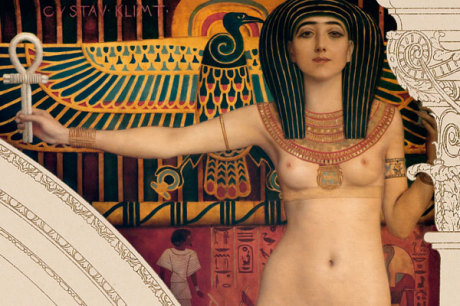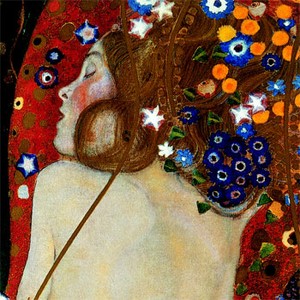Gustav Klimt
Vienna
In 1890/91 the twenty-eight-year-old Gustav Klimt executed a number of paintings to decorate the spaces between the columns and above the arcades along the north wall of the KHM’s main staircase. The committee in charge of the newly-built Imperial Museum of Fine Arts (today the Kunsthistorisches Museum) had commissioned a series of forty paintings from a group of young artists called the Company of Artists – Gustav Klimt, his younger brother Ernst, and Franz Matsch – featuring different periods of art from Ancient Egypt to the 18th century.
Personifications – either male and female, or female only – symbolize different stylistic periods, regions or centers of art. Pose, costume and selected objects perfectly reflect style and artifacts typical of each period.
Gustav Klimt contributed a total of thirteen paintings. All were executed in oil on canvas in the Company of Artists’ communal studio; in 1891, six months before the formal opening of the museum, they were glued to the wall of the main staircase.
Gustav Klimt (July 14, 1862– February 6, 1918) was an Austrian Symbolist painter and one of the most prominent members of the Vienna Secession movement. His major works include paintings, murals, sketches, and other art objects. Klimt’s primary subject was the female body.


Until January 6th, 2013
Maria-Theresien-Platz
1010 Vienna
Austria
Archive
- Dezember 2016 (1)
- Oktober 2016 (3)
- September 2016 (24)
- Juli 2016 (20)
- Juni 2016 (24)
- Mai 2016 (18)
- April 2016 (18)
- März 2016 (21)
- Februar 2016 (11)
- Januar 2016 (20)
- Dezember 2015 (20)
- November 2015 (37)
- Oktober 2015 (30)
- September 2015 (24)
- August 2015 (4)
- Juli 2015 (30)
- Juni 2015 (9)
- Mai 2015 (17)
- April 2015 (23)
- März 2015 (18)
- Januar 2015 (8)
- Dezember 2014 (1)
- November 2014 (3)
- Oktober 2014 (10)
- September 2014 (4)
- August 2014 (2)
- Juli 2014 (3)
- Juni 2014 (2)
- Mai 2014 (5)
- April 2014 (11)
- März 2014 (12)
- Februar 2014 (13)
- Januar 2014 (10)
- Dezember 2013 (5)
- November 2013 (13)
- Oktober 2013 (24)
- September 2013 (18)
- August 2013 (26)
- Juli 2013 (13)
- Juni 2013 (35)
- Mai 2013 (44)
- April 2013 (49)
- März 2013 (61)
- Februar 2013 (54)
- Januar 2013 (46)
- Dezember 2012 (50)
- November 2012 (58)
- Oktober 2012 (62)
- September 2012 (61)
- August 2012 (63)
- Juli 2012 (64)
- Juni 2012 (61)
- Mai 2012 (63)
- April 2012 (51)
- März 2012 (67)
- Februar 2012 (37)



